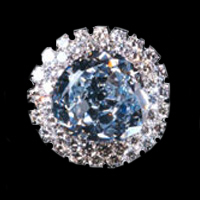




Looking After Your Finds - Reference

Powered By Sispro1
Designed by Nigel G Wilcox
Famous Diamonds

The Idol's Eye Diamond
Idol Eye DiamondThe assorted published accounts of the premature times gone by of the Idol's Eye are worth of being incorporated in A Thousand and One Nights, regrettably, for the most measurement they must be measured to be completely bogus. The diamond may have been established at Golconda around 1600, but 7 years afterward it was absolutely not apprehended from the Persian Prince Rahab by the East India Company as imbursement for debt. No such human being is recorded in the history of Persia, and the East India Company was not fashioned until numerous years later.
The first genuine fact in the diamond's olden times was its manifestation at a Christie's sale in London on July 14th, 1865, when it was spelled as "a grand large diamond recognized as the Idol's Eye set round with 18 minor brilliants and a chasis of diminutive brilliants." It was punched down to a inexplicable buyer purely nominated as "B.B.". Later it is stated that the 34th Ottoman Sultan, Abdul Hamid II (1842-1918) possessed the Idol's Eye. However the Idol's Eye would on no account, as has frequently been asserted, has been positioned in the eye of a place of worship in Benghazi for the reason that there are neither temples nor idols in that city, Benghazi having been Muslim from the time of the 8th century AD.
In 1979 Laurence Graff of London traded the Idol's Eye. Harry Levinson pawned the diamond, before it was sold to Laurence Graff, for exhibit at the Metropolitan Museum of Art in New York, at a 1982 function celebrating the 50th anniversary of Harry Winston Inc. In the subsequent January, Mr. Graff sold the Idol's eye; jointly with the Emperor Maximilian and a 70.54-carat conjure Yellow diamond christened the Sultan Abdul Hamid II and contemplated to have once been element of that ruler's jewellery compilation. The sale of these 3 diamonds to the identical buyer is measured to have been one of the peak priced dealings ever recognized.
Idol Eye DiamondThe assorted published accounts of the premature times gone by of the Idol's Eye are worth of being incorporated in A Thousand and One Nights, regrettably, for the most measurement they must be measured to be completely bogus. The diamond may have been established at Golconda around 1600, but 7 years afterward it was absolutely not apprehended from the Persian Prince Rahab by the East India Company as imbursement for debt. No such human being is recorded in the history of Persia, and the East India Company was not fashioned until numerous years later.
The first genuine fact in the diamond's olden times was its manifestation at a Christie's sale in London on July 14th, 1865, when it was spelled as "a grand large diamond recognized as the Idol's Eye set round with 18 minor brilliants and a chasis of diminutive brilliants." It was punched down to a inexplicable buyer purely nominated as "B.B.". Later it is stated that the 34th Ottoman Sultan, Abdul Hamid II (1842-1918) possessed the Idol's Eye. However the Idol's Eye would on no account, as has frequently been asserted, has been positioned in the eye of a place of worship in Benghazi for the reason that there are neither temples nor idols in that city, Benghazi having been Muslim from the time of the 8th century AD.
In 1979 Laurence Graff of London traded the Idol's Eye. Harry Levinson pawned the diamond, before it was sold to Laurence Graff, for exhibit at the Metropolitan Museum of Art in New York, at a 1982 function celebrating the 50th anniversary of Harry Winston Inc. In the subsequent January, Mr. Graff sold the Idol's eye; jointly with the Emperor Maximilian and a 70.54-carat conjure Yellow diamond christened the Sultan Abdul Hamid II and contemplated to have once been element of that ruler's jewellery compilation. The sale of these 3 diamonds to the identical buyer is measured to have been one of the peak priced dealings ever recognized.

The Idol's Eye

The Sancy Diamond
The Sancy Diamond
Sancy Diamond is comprehensible how a guest to the French Crown Jewel compilation housed at the Louvre could fail to notice the Sancy Diamond. A measly 55.232 carats and bordered by a uncomplicated rings of white gold, it resides in its container like a introverted diminutive sister in conjunction with its grander siblings, the dignified Regent and the peach-blossom Hortensia. Yet, if diamonds could converse, none could counterpart the Sancy for the untamed tales it could acquaint with, Like the Scheherazade of diamonds, it would maintain a listener.
Spellbound with a thousand-and-one stories of war and conspiracy, splendor and ceremony, and the foibles and follies of the sovereigns, lords, ladies, moneymen, and schemers who owned, desired after, and even killed to posses it.
It is comprehensible how a guest to the French Crown Jewel compilation housed at the Louvre could fail to notice the Sancy Diamond. A measly 55.232 carats and bordered by a uncomplicated rings of white gold, it resides in its container like a introverted diminutive sister in conjunction with its grander siblings, the dignified Regent and the peach-blossom Hortensia. Yet, if diamonds could converse, none could counterpart the Sancy for the untamed tales it could acquaint with, Like the Scheherazade of diamonds, it would maintain a listener spellbound with a thousand-and-one stories of war and conspiracy, splendor and ceremony, and the foibles and follies of the sovereigns, lords, ladies, moneymen, and schemers who owned, desired after, and even killed to posses it.
In this 1st widespread history of one of the world's most desirable gems, historian Susan Ronald brings to glowing life the Sancy Diamond's 600-year odyssey-a labyrinthine expedition that begins in the fabled mines of Golconda, India, and wends its means across 3 continents and through some of the most stunning events in European history.
Once the chief white diamond in the Western world, the Sancy was considered to communicate invincibility to whoever wore it. Ironically, it was also whispered to be the source of an antique curse that visited a brutal death to any who possessed it. Over the centuries, the diamond decorated the crowns of numerous French royals and was worn as a fortunate hatpin by King James I of England. In the 15th century, it was lost on the field of battle by Charles the Bold of Burgundy only to be spotted by a Swiss soldier who sold it for 1 florin to a priest from Basel. In the 16th century, while en route to be wagered to elevate a mercenary Swiss army, it was cleaved from the vitals of King Henry IV's wretched courier who had swallowed it in order to mask it from robbers. Won and lost by the kings of Portugal and lusted-after by quite a few Spanish monarchs, the intangible Sancy was hotly tracked for decades by England's Elizabeth I, Taken away from the Louvre and concealed under the floorboards of a Parisian loft during the French Revolution, and was influential in Napoleon's meteoric augment to power.
In The Sancy Blood Diamond, Susan Ronald outlines the stone's advancement as it passes in the midst of the royal and gracious houses of Europe, from John Galeazzo di Visconti, Duke of Milan in the 14th century, to England's Charles I, France's Louis XVI, a Russian prince of serf origins, and eventually, the British Astors. All along the way, she discovers the origins of the fable of the Sancy pest, and, working from unique sources, she decisively solves the puzzle of the Sancy's 2 disappearances, the first time that spanned for 120 years, in the 16th and 17th centuries, and then another time, during the French Revolution.
Sancy Diamond is comprehensible how a guest to the French Crown Jewel compilation housed at the Louvre could fail to notice the Sancy Diamond. A measly 55.232 carats and bordered by a uncomplicated rings of white gold, it resides in its container like a introverted diminutive sister in conjunction with its grander siblings, the dignified Regent and the peach-blossom Hortensia. Yet, if diamonds could converse, none could counterpart the Sancy for the untamed tales it could acquaint with, Like the Scheherazade of diamonds, it would maintain a listener.
Spellbound with a thousand-and-one stories of war and conspiracy, splendor and ceremony, and the foibles and follies of the sovereigns, lords, ladies, moneymen, and schemers who owned, desired after, and even killed to posses it.
It is comprehensible how a guest to the French Crown Jewel compilation housed at the Louvre could fail to notice the Sancy Diamond. A measly 55.232 carats and bordered by a uncomplicated rings of white gold, it resides in its container like a introverted diminutive sister in conjunction with its grander siblings, the dignified Regent and the peach-blossom Hortensia. Yet, if diamonds could converse, none could counterpart the Sancy for the untamed tales it could acquaint with, Like the Scheherazade of diamonds, it would maintain a listener spellbound with a thousand-and-one stories of war and conspiracy, splendor and ceremony, and the foibles and follies of the sovereigns, lords, ladies, moneymen, and schemers who owned, desired after, and even killed to posses it.
In this 1st widespread history of one of the world's most desirable gems, historian Susan Ronald brings to glowing life the Sancy Diamond's 600-year odyssey-a labyrinthine expedition that begins in the fabled mines of Golconda, India, and wends its means across 3 continents and through some of the most stunning events in European history.
Once the chief white diamond in the Western world, the Sancy was considered to communicate invincibility to whoever wore it. Ironically, it was also whispered to be the source of an antique curse that visited a brutal death to any who possessed it. Over the centuries, the diamond decorated the crowns of numerous French royals and was worn as a fortunate hatpin by King James I of England. In the 15th century, it was lost on the field of battle by Charles the Bold of Burgundy only to be spotted by a Swiss soldier who sold it for 1 florin to a priest from Basel. In the 16th century, while en route to be wagered to elevate a mercenary Swiss army, it was cleaved from the vitals of King Henry IV's wretched courier who had swallowed it in order to mask it from robbers. Won and lost by the kings of Portugal and lusted-after by quite a few Spanish monarchs, the intangible Sancy was hotly tracked for decades by England's Elizabeth I, Taken away from the Louvre and concealed under the floorboards of a Parisian loft during the French Revolution, and was influential in Napoleon's meteoric augment to power.
In The Sancy Blood Diamond, Susan Ronald outlines the stone's advancement as it passes in the midst of the royal and gracious houses of Europe, from John Galeazzo di Visconti, Duke of Milan in the 14th century, to England's Charles I, France's Louis XVI, a Russian prince of serf origins, and eventually, the British Astors. All along the way, she discovers the origins of the fable of the Sancy pest, and, working from unique sources, she decisively solves the puzzle of the Sancy's 2 disappearances, the first time that spanned for 120 years, in the 16th and 17th centuries, and then another time, during the French Revolution.
Copyright All Rights Reserved by Nigel G Wilcox E-Mail: ngwilcox100@gmail.com
Rocks & Minerals Index
Complimentary Topics
The Paragon Of Metal Detecting
& Archaeology
& Archaeology
Who Owns the World's Gold?
Pages
Member NCMD
Reference Menu
Group Pages
[1]
[2]
[3]
[4]
[5]
[6]
[7]
[8]
Famous Diamonds




















